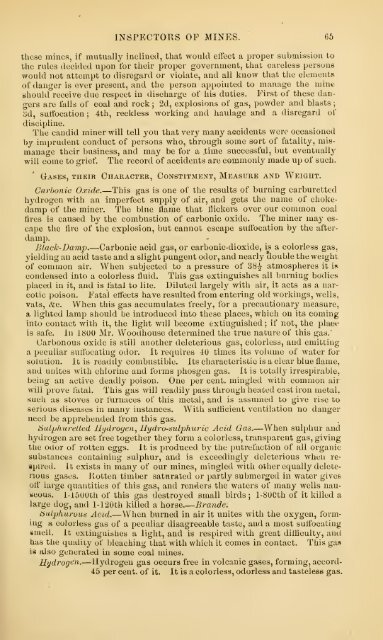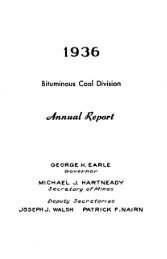1873 - Old Forge Coal Mines
1873 - Old Forge Coal Mines
1873 - Old Forge Coal Mines
You also want an ePaper? Increase the reach of your titles
YUMPU automatically turns print PDFs into web optimized ePapers that Google loves.
INSPECTORS OF MINES. 65<br />
these mines, if mutually inclined, that would effect a proper submission to<br />
the rules decided upon for their proper government, that careless persons<br />
would not attempt to disregard or violate, and all know that the elements<br />
of danger is ever present, and the person appointed to manage the mine<br />
should receive due respect in discharge of his duties. First of these dangers<br />
are falls of coal and rock ; 2d, explosions of gas, powder and blasts<br />
;<br />
yd, suffocation ;<br />
4th, reckless working and haulage and a disregard of<br />
discipline.<br />
The candid miner will tell you that very many accidents were occasioned<br />
by imprudent conduct of persons who, through some sort of fatality, mismanage<br />
their business, and may be for a .time successful, but eventually<br />
will come to grief. The record of accidents are commonly made up of such.<br />
Gases, their<br />
Character, Constitment, Measure and Weight.<br />
Carbonic Oxide This gas is one of the results of burning carburetted<br />
hydrogen with an imperfect supply of air, and gets the name of chokedamp<br />
of the miner. The blue name that nickers over our common coal<br />
fires is caused by the combustion of carbonic oxide. The miner may escape<br />
the fire of the explosion, but cannot escape suffocation by the afterdamp.<br />
Black-Damp.—Carbonic acid gas, or carbonic-dioxide, is a colorless gas,<br />
yielding an acid taste and a slight pungent odor, and nearly double the weight<br />
of common air. When subjected to a pressure of 38^ atmospheres it is<br />
condensed into a colorless fluid. This gas extinguishes all burning bodies<br />
placed in it, and is fatal to lite. Diluted largely with air, it acts as a narcotic<br />
poison. Fatal effects have resulted from entering old workings, wells,<br />
vats, Ac. When this gas accumulates freely, for a precautionary measure,<br />
a lighted lamp should be introduced into these places, which on its coming<br />
into contact with it, the light will become extinguished ; if not, the place<br />
is safe. In 1800 Mr. Woodhouse determined the true nature of this gas.<br />
Carbonous oxide is still another deleterious gas, colorless, and emitting<br />
a peculiar suffocating odor. It requires 40 times its volume of water for<br />
solution. It is readily combustible. Its characteristic is a clear blue flame,<br />
and unites with chlorine and forms phosgen gas. It is totally irrespirable,<br />
being an active deadly poison. One per cent, mingled with common air<br />
will prove fatal. This gas will readily pass through heated cast iron metal,<br />
such as stoves or furnaces of this metal, and is assumed to give rise to<br />
serious diseases in many instances. With sufficient ventilation no danger<br />
need be apprehended from this gas.<br />
Sulphuretted Hydrogen, Hydro-sulphuric Acid Gas.—When sulphur and<br />
hydrogen are set free together they form a colorless, transparent gas, giving<br />
the odor of rotten eggs. It is produced by the putrefaction of all organic<br />
substances containing sulphur, and is exceedingly deleterious when respired.<br />
It exists in many of our mines, mingled with other equally deleterious<br />
gases. Rotten timber saturated or partly submerged in water gives<br />
off large quantities of this gas, and renders the waters of many wells nauseous.<br />
l-i500th of this gas destroyed small birds ; l-80Cth of it killed a<br />
large dog, and 1-1 20th killed a horse Brande.<br />
Sulphurous Acid.— When burned in air it unites with the oxygen, forming<br />
a colorless gas of a peculiar disagreeable taste, and a most suffocating<br />
smell. It extinguishes a light, and is respired with great difficulty, and<br />
has the quality of bleaching that with which it comes in contact. This gas<br />
is also generated in some coal mines.<br />
Hydrogen.—Hydrogen gas occurs free in volcanic gases, forming, accord-<br />
45 per cent, of it. It is a colorless, odorless and tasteless gas.




![1945 Anthracite Annual Report Districts 19 - 25 [Adobe pdf - 9148Kb]](https://img.yumpu.com/50308099/1/190x119/1945-anthracite-annual-report-districts-19-25-adobe-pdf-9148kb.jpg?quality=85)


![1937 Anthracite Annual Report Districts 1 - 11 [Adobe pdf - 9394Kb]](https://img.yumpu.com/43539962/1/190x119/1937-anthracite-annual-report-districts-1-11-adobe-pdf-9394kb.jpg?quality=85)






![1931 Anthracite Annual Report Districts 1 - 11 [Adobe pdf - 8007Kb]](https://img.yumpu.com/39427789/1/190x119/1931-anthracite-annual-report-districts-1-11-adobe-pdf-8007kb.jpg?quality=85)

